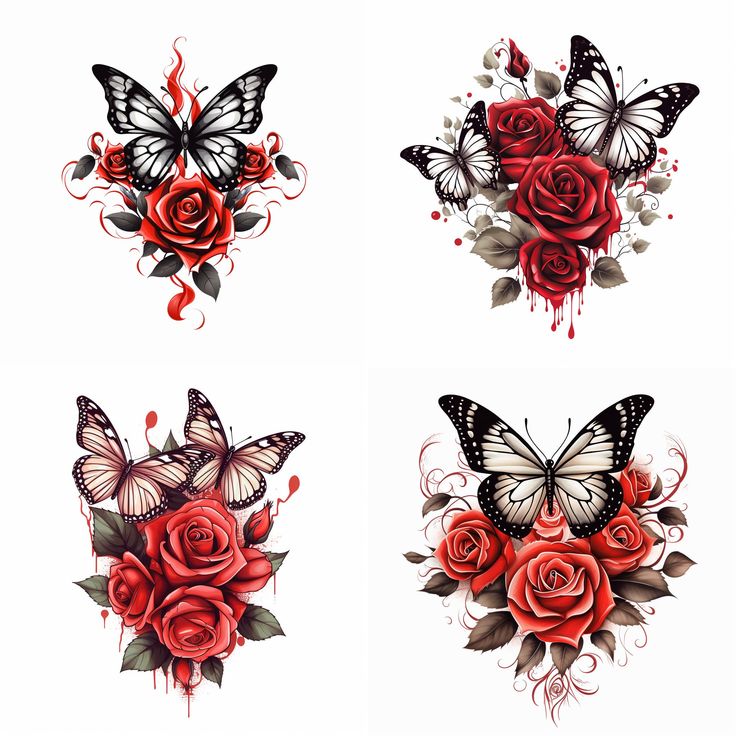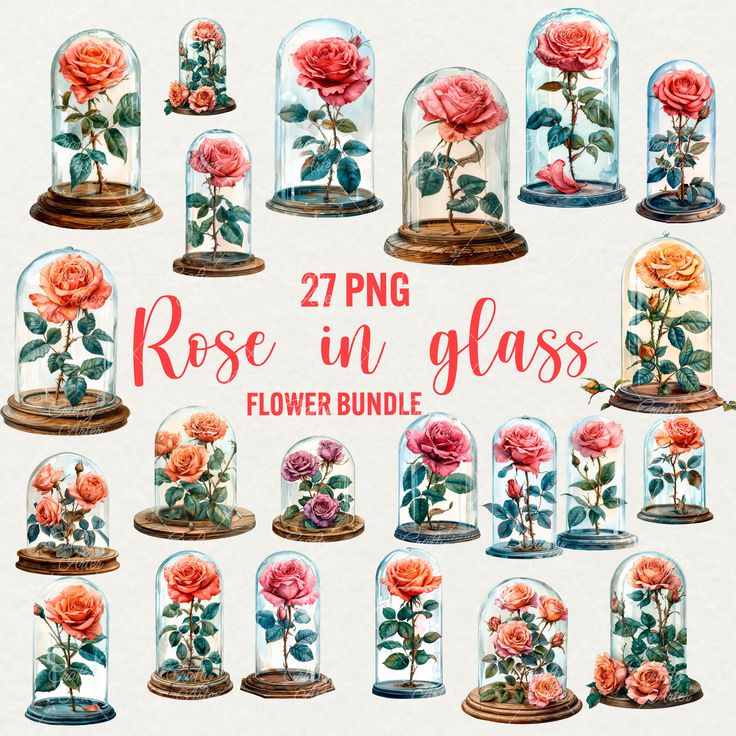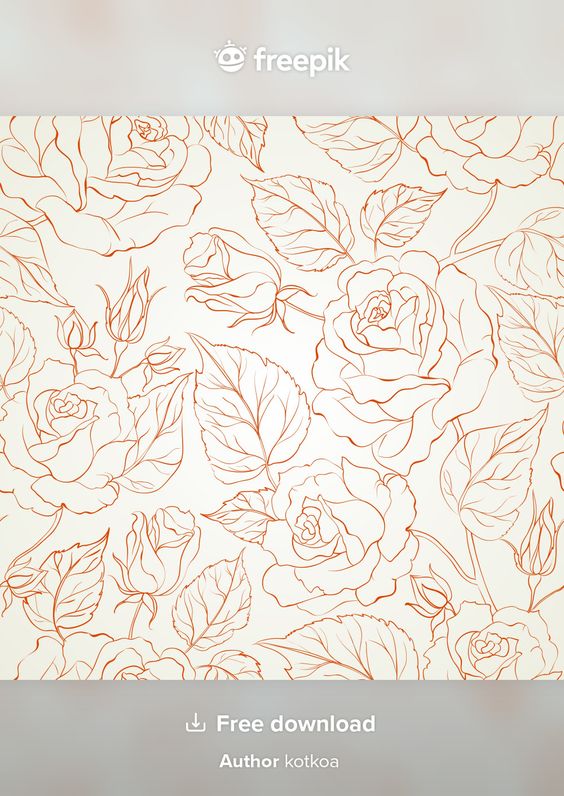Exploring creative possibilities with rose drawings can be both inspiring and rewarding. This article presents over ten unique ideas to help artists enhance their skills and express their love for this timeless flower. Whether a novice or more experienced, there is something here for everyone to enjoy.
From simple line art to intricate designs, rose drawing can take many forms. Each idea offers an opportunity to experiment with styles and techniques, making it easy to find the perfect approach that resonates with individual creativity.
Rose Outline with Thorns


Creating a rose outline with thorns is a fantastic way to explore floral design. This idea combines beauty with an exciting edge, showcasing the unique features of the rose.
Start with a simple outline of the rose’s petals. Curved lines can give it a flowing and elegant look. The shape should highlight the delicate nature of the flower.
Next, add thorns along the stem. These sharp, pointed shapes contrast beautifully with the soft petals. It’s an opportunity to play with angles and sizes.
Consider varying the thickness of the lines for the petals and thorns. Thicker lines can emphasize strength, while thinner lines offer softness. This difference creates a captivating visual balance.
In this drawing, shading can enhance the dimensions. Use light strokes to indicate shadows around the petals and thorns. This adds depth and makes the outline more dynamic.
Lastly, incorporating a few leaves can enrich the composition. They can wrap around the stem or sit at angles to complement the rose. This small addition brings more life to the outline.
Experimenting with colors or keeping it monochrome can also yield stunning results. Each approach will shine a different light on the beauty and complexity of the rose.
2) Watercolor Rose Bouquet


Creating a watercolor rose bouquet can be a delightful experience. It allows for the vibrant hues and delicate blending that only watercolor can achieve.
Beginning with light washes, she can paint the petals in soft pinks, reds, or any shades she prefers. This gentle approach helps capture the ethereal quality of roses.
She can add depth by layering darker colors, giving the bouquet a more three-dimensional look. Mixing in greens for leaves will enhance the overall composition.
Adding splashes of contrasting colors will make the bouquet pop. A touch of gold or yellow can illuminate certain areas, creating highlights.
This technique encourages creativity as she explores different brush strokes and patterns. The fluid nature of watercolor makes each piece unique and personal.
By experimenting with the arrangement and colors, the final artwork becomes a stunning representation of a rose bouquet. Each painting tells its own story, filled with charm and beauty.
3) Abstract Rose Art


Abstract rose art brings a unique twist to traditional floral drawings. It invites creativity and allows for personal expression.
Artists can experiment with shapes, colors, and forms that may not represent a rose realistically. This freedom can lead to vibrant and imaginative interpretations.
Using bold lines and unexpected hues can transform an ordinary rose into a striking piece of art. This approach encourages thinking outside the box.
Incorporating geometric patterns or splashes of color can add depth and movement. Such pieces often evoke emotional responses, sparking intrigue and conversation.
Abstract rose art offers endless possibilities, inspiring artists to create something entirely their own. It’s a fantastic way to blend nature with individual style.
4) Realistic Rose Sketch


Creating a realistic rose sketch is an exciting challenge for artists. By focusing on details, they can bring a rose to life on paper.
Start with light pencil strokes to outline the shape of the rose. This initial structure helps establish the petals and overall composition.
Next, artists add depth by layering shading techniques. Cross-hatching and stippling can create texture, making petals appear soft and delicate.
Highlighting areas where light naturally hits the flower adds dimension. This step is crucial for achieving that lifelike quality.
Using colored pencils or watercolors can enhance the sketch further. Subtle color variations mimic the natural beauty of roses.
Incorporating the stem and leaves will complete the presentation. Observing real roses will aid in capturing their unique characteristics.
She would be thrilled as she sees the rose becoming more lifelike with every stroke. A realistic rose sketch is not just art; it’s a celebration of nature’s elegance.
5) Rose and Butterfly Design


The combination of roses and butterflies creates a vibrant and enchanting design. This pairing can symbolize beauty and transformation, making it a popular choice for artists.
When illustrating a rose and butterfly, they can be intertwined or positioned side by side. Positioning a butterfly delicately perched on a rose adds an element of grace.
Artists can experiment with colors to enhance the visual appeal. Bright, bold hues for the butterfly contrast beautifully with the soft tones of a rose.
This design can be adapted to various styles, from realistic to abstract. Each interpretation offers a unique charm, inviting creativity.
Incorporating detailed patterns on the butterfly’s wings adds depth to the artwork. Shading techniques can highlight the petals of the rose, making the entire piece more dynamic.
Using this design in sketches, tattoos, or digital art can bring joy and inspiration. The rose and butterfly design is versatile and can suit any artist’s preference.
6) Rose in a Glass Dome


Creating a drawing of a rose in a glass dome is a delightful way to capture elegance. The dome can represent protection and beauty, framing the rose like a precious treasure.
To start, the outline of the dome should be smooth and symmetrical. This provides a soft backdrop for the rose’s intricate details. The glass effect can be achieved by using light, transparent shading.
Next, focus on the rose itself. Capture the delicate petals with soft curves and varying shades of color. Consider adding textures to convey softness and depth.
Details enhance the drawing’s realism. Adding subtle reflections on the dome will simulate glass effectively. Highlight the contours of the rose to create contrast.
This drawing idea combines fantasy and reality, making it visually captivating. It allows for a mix of techniques, from shading to detailing. Experimenting with colors can add a dynamic touch to the piece.
Incorporating a simple background can also enhance the overall effect. A soft gradient or light splash can draw attention to the glass dome and the rose within. This makes the subject stand out beautifully.
7) Geometric Rose Patterns


Geometric rose patterns combine the beauty of floral designs with sharp, modern shapes. These patterns are visually striking and offer a fresh take on traditional rose artwork.
Artists can experiment with triangles, circles, and lines to create unique interpretations of roses. By integrating bold colors and varying line weights, they can produce dynamic images that capture attention.
One popular approach is to use a repeating pattern of roses formed by simple geometric shapes. This style can add a contemporary feel to home décor or fashion design.
Another exciting idea involves layering roses with a mix of geometric forms. This technique introduces depth and dimension to the artwork, making it even more engaging.
Using geometric rose patterns can also help artists practice precision in their drawing skills. It encourages them to think critically about composition and balance in their pieces.
Overall, the blend of floral softness with geometric precision creates an exciting contrast that many find appealing. Geometric rose patterns are a fantastic exploration for any artist looking to innovate.
8) Tim Burton Style Roses
Tim Burton’s artistic style is wonderfully unique, characterized by dark whimsy and gothic elements. When drawing roses inspired by him, one can explore unconventional shapes and eerie twists.
These roses often have elongated stems and oversized, scraggly petals, giving them an otherworldly look. Using sharp contrasts of black and white or muted, haunting colors amplifies their mysterious charm.
Incorporating quirky details, such as spirals or exaggerated thorns, adds to the Tim Burton aesthetic. Adding whimsical characters, like creatures lurking among the flowers, can bring extra life to the drawing.
Using a sketchy line quality or playful textures adds depth and intrigue. The art can play on light and shadow for a dramatic effect, creating a captivating visual experience.
Tim Burton style roses evoke a sense of fantasy and imagination. They can transport viewers to an enchanting yet slightly unsettling world where beauty meets the bizarre.
9) Vintage Rose Illustration


Vintage rose illustrations capture the timeless beauty of roses with elegant details. Artists enjoy using soft lines and muted colors to evoke a sense of nostalgia.
To create a vintage rose, it often helps to study traditional botanical illustrations. They emphasize intricate petal shapes and gentle shading, giving depth to the flowers.
Adding antique elements, like decorative frames or faded backgrounds, enhances the vintage feel. Soft pastels or sepia tones can make your illustration appear aged and classic.
Many artists choose to incorporate text, such as poetic quotes or vintage labels, alongside their illustrations. This combination adds character and context, making the artwork even more engaging.
Playing with different styles, like Art Nouveau or Victorian, can provide inspiration for unique designs. Each era has its own charm, allowing for creative expression in every piece.
Vintage rose illustrations remain popular for greeting cards, home decor, and art prints. They bring elegance and a touch of history to any setting, making them a delightful subject for artists of all levels.
10) Rose with Dew Drops


Drawing a rose with dew drops creates an enchanting scene. The way dew glistens on the petals brings the flower to life. Artists can capture this delicate beauty through careful observation.
To illustrate dew drops, it’s effective to use highlights and shadows. The contrast makes the droplets look realistic. Small white highlights can express the reflection of light on the water.
Choosing the right colors for the rose adds depth. Soft pinks or vibrant reds can enhance the overall effect. Green leaves can provide a beautiful backdrop, emphasizing the rose’s elegance.
Artists can experiment with different techniques. Watercolors might give a soft, dreamy quality, while colored pencils can add intricate details. Each medium offers unique advantages to portray the dew’s charm.
Including a gentle background, like a blurred garden scene, helps focus on the rose. This setting creates a sense of tranquility, perfect for showcasing the delicate dew drops. This idea can inspire creativity and showcase artistic skills in capturing nature’s beauty.
Exploring Different Drawing Styles


Artists can capture the beauty of roses in numerous ways. By experimenting with various styles, they unveil multiple perspectives on this timeless flower. Two compelling approaches are realistic and abstract interpretations.
Realistic Rose Drawings
In realistic rose drawings, the focus is on capturing the intricate details and lifelike qualities of the flower. Artists often pay close attention to shading, color blending, and fine lines to recreate the delicate petals and leaves.
Key techniques include:
- Observational Sketching: Drawing directly from a live rose or photo helps achieve accuracy.
- Layering: Applying multiple layers of color or graphite enhances depth.
- Use of Light and Shadow: Highlighting and shadowing create a three-dimensional effect.
A realistic approach allows artists to convey the vibrancy and fragility of roses, making the artwork relatable and visually stunning.
Abstract Rose Interpretations
Abstract rose interpretations offer a fresh take that moves away from realism. This style encourages artists to explore shape, color, and form without the constraints of reality.
Characteristics include:
- Simplified Forms: Using shapes to suggest rose petals instead of detailing each one.
- Bold Colors: Vibrant hues can evoke emotions and set a mood.
- Dynamic Lines: Expressive lines and patterns add movement and intrigue.
This approach invites creativity, making it possible to express personal feelings or interpretations that resonate differently with viewers. Abstract rose drawings can be a powerful way to challenge perceptions and spark imagination.
Materials and Tools for Rose Drawing
Selecting the right materials and tools is crucial for creating stunning rose drawings. The choice of pencils or watercolors will significantly impact the final artwork.
Choosing the Right Pencils
Pencils play a vital role in defining the details and textures of a rose. Artists often prefer using a range of graphite pencils, typically from 2H to 6B.
| Pencil Type | Hardness | Use |
|---|---|---|
| 2H | Hard | Fine lines and details |
| HB | Medium | General drawing |
| 4B | Softer | Shading and soft areas |
| 6B | Very Soft | Deep shadows |
For fine lines and precise detailing, a sharper pencil gives better control. Softer pencils allow for richer shades and softer transitions.
Using blending tools such as tortillons or blending stumps can smooth out transitions and enhance realism. Key to mastering pencil drawing is layering; building depth gradually can create a lifelike appearance.
Using Watercolors for a Soft Touch
Watercolors offer a unique softness that can beautifully capture the delicate petals of a rose. When selecting watercolors, artists might opt for tubes or pans—both have distinct advantages.
Benefits of Watercolor Types:
- Tubes: Allow for greater mixing and vibrant application.
- Pans: Offer convenience, especially for travel and quick setups.
To bring roses to life, it’s essential to observe color gradients. Mixing various shades results in more realistic petals.
Using wet-on-wet techniques can produce soft washes, while wet-on-dry provides sharp edges for details. Adding layers gradually builds depth, making flowers appear more dimensional.
Overall, using the right combination of tools enhances creative expression in rose drawings.
- 465shares
- Facebook0
- Pinterest465
- Twitter0


